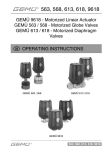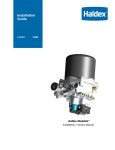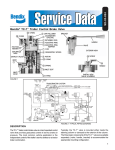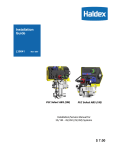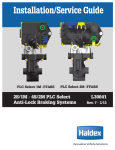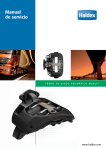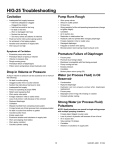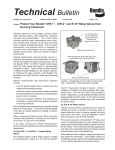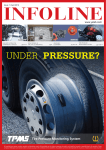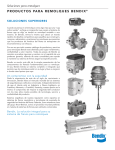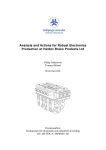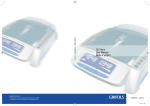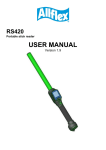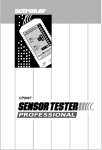Download EB+ User Guide - Well Interparts Online
Transcript
Operator’s Guide ELECTRONIC BRAKE SYSTEMS EB+ GEN 2 www.haldex.com Contents Page EB+ GEN 2 Operator’s guide 2 General Components Guide 3 System Layout 4 Chassis Components 5 System Diagnostics 6 Warning Device, System Check Procedure and Power-Up Modes 7 Test Procedure 8 Diagnostic Trouble Codes (DTC) 9 ECU Connector Identification 11 Wiring diagram 12 Piping Diagrams 13 Multimeter Reading 17 Recommended Maintenance Schedule 18 Part Reference 19 General Information 21 Your trailer has been fitted with the latest technology Haldex Electronic Braking System EB+ Gen 2. This system has been specifically designed to be effective, reliable and easy to service. The purpose of this booklet is to describe the components involved and give you sufficient information to make your use of the system easy. Concept EB+ Gen2 = Antilock Brake System (ABS) + Electronic Load Sensing (ELS) + CAN (Controller area network ISO11992 data link - computer data from and to the towing vehicle) The system reacts to electrical or pneumatic signal from the towing vehicle. It electronically processes those signals plus signals received from other sensors on the trailer. In response to those signals the EB+Gen 2 regulates pressure to the brake chambers. System Description The position of the various components is shown in Tri-axle layout, Fig 1. The system is equally compatible with single and tandem axles. The EB+ Gen 2 system is an integrated construction of an encapsulated Electronic Control Unit (ECU), Electro pneumatic relay valves (EPRV’s), over moulded connectors, integrated pressure transducers and a flash upgradable program memory. Onset of braking is denoted by presence of a demand on the ISO11992 data link (CAN) via the ISO7638 connector. Driver demand pressure is then determined electronically either by the data link or control line pressure transducer within the EPRV’s assembly. The demand pressure is then modified using data from the air suspension (Electronic Load Sensing), and may be further modified when a wheel speed sensor detects imminent locking of the sensed wheels (ABS). The output to the brakes is exercised by the ECU control of the EPRV’s see Fig 2. The EB+ Gen2 ECU also provides up to 5 auxilliary functions such as automatic reset-to-ride height (COLAS®), lift axle control (ILAS®-E), retarder and Stability control. EB+ Gen 2 incorporates an odometer facility which measures total distance of the trailer and its read-out is shown on an optional EB+ Info Centre unit (Only when powered by the ISO7638 cable). The EB+ Info Centre is a side of trailer mounted unit used also for read-out of diagnostic codes and other information available from the EB+ Gen 2 ECU. The EB+ Gen 2 also incorporates an enhanced information storage and retrieval facility. For the fleet operator, a ‘Fleet Log Reader’ allows the compilation of a full history of each trailer or long term monitoring. For the trailer manufacturer, an ‘End-of-line’ Testing (EOLT) to confirm correct performance of the EB+ Gen 2 system. General Components Guide Haldex EB+ Gen 2 Assembly Sensor and Exciter ISO7638 - 7 Pin Socket assembly Driver’s information plate EB+ Info Centre Park/Shunt and REV Options Option 1 Option 2 Option 3 TrCM Relay Emergency Valve (REV) Optional position and Park & Shunt valve Park & Shunt valve Fig. 1 3 System Layout The system fitted to your trailer may have 2 or 4 Sensors and 2 Modulators (EPRV's). The variants available being 2S/2M and 4S/2M. As a safety back-up ISO1185 (24N) - Stop Light powering provides ABS function Fig 4. The powering of the system is via : ISO7638- 7 Pin - Full EBS function Fig 2. The ISO7638 controls a Trailer warning device in the driver’s console . The EB+ Gen 2 system can also be powered via : ISO7638- 5 Pin - (No CAN data bus) ABS + ELS function only Fig 3. The warning device has two functions: • To indicate system integrity via the correct sequence (see Figs 10 and 11 on page 10) every time the EB+ Gen 2 ECU is electrically powered up. • To indicate by a permanent display, when the vehicle is moving, if a fault has been detected. The layout of the chassis components are shown in Fig 5 ISO7638 - 7 Pin Fig 2 EBS EB+ = Full EBS function ISO7638 - 5 Pin Fig 3 ABS EB+ = ABS + ELS function only No CAN data bus ISO1185 - (24N) Fig 4 4 ABS/EBS EB+ = On foot brake application ABS function only Chassis Components Electrical connections 7 1 7 6 6 ISO 7638 11 2 1B 3 2 ISO 1185 (24N) 4 1A 2B 10 1 3 5 2A 5 9 4 6 6 8 7 7 Fig. 5 Item 1 Description EB+ Gen 2 Label 2 ISO7638 - 7 Pin Socket assembly 3 Safety backup cable - ISO1185 (24N) 4 EB+ Gen 2 Info Centre (side of vehicle connection) Notes 5 EB+ Gen 2 ECU and EPRV’s assembly 6 Sensor assembly 7 Exciter 8 COLAS® Aux 1, 2 or 3 9 ILAS®-E Aux 1, 2 or 3 10 Lining Wear Sensing (LWS) EB+ Gen 2 Stability Aux 4 ONLY 11 External Sensor Assembly - Aux 5 ONLY Note: Aux to be set in line with DIAG+ 5 System Diagnostics An important feature of the EB+ Gen 2 system is that it provides an extensive on board diagnostic capability. The system displays a range of codes, which allow rapid diagnosis of the problem should one occur. Diagnostic communication is in accordance to ISO11898 using Keyword (KWP2000) protocol and is accessed by either the ISO7638 - 7 pin connector which uses pin 6 and 7 as a CAN data bus using ISO Interface Assembly (815 018 001) or optional side-of-vehicle connector or directly to ECU (Fig 7). Any suitable device connected to this CAN data bus may read diagnostic information. An EB+ Gen 2 Info Centre can be connected permanently to the ECU's diagnostic 'DIAG' connection. While the ECU is powered information is transferred to the Info Centre's memory, which can be recalled. Power is supplied from the vehicle system via the ECU diagnostics connector. Alternative positions Fig 6 For further information on EB+ Gen 2 Info Centre see user guide (000 700 270). The EB+ Gen 2 Info Centre provides a multi-digit display of: PC Interface Information: • Read Diagnostic Trouble Code (DTC) • Clear DTC • Configuration • ECU software version number • ECU serial number • Vehicle Ident Number (VIN) • Manufacturer OEM • Info Centre software version number PC Interface Distance: • Odometer - Total distance • Trip distance (1st and 2nd) • Service distance • Wheel scale factor • Clock (time and date) • Clear Trip 1 and 2 ISO Interface assembly Changes: • Service distance • Service interval • Wheel scale factor • Clock (time and date) • Options-on/off (parameter updating / backlight) • Password (PIN number) • Unlock Info Centre (PIN number unknown) Connect to ECU directly or via side-of-vehicle connector Diagnostic connection 'DIAG' on ECU Testing: • Load • Wheels (sensor / cabling check) • Pressure • Plate (Load plate data) • Auxiliaries • Brake Test • Lining Wear Indication A Haldex PC based program DIAG+ may be used for more advanced diagnosis. This also allows configuration with system parameters to be entered and an End-of-Line Test to be carried out. PC INTERFACE Fig 7 Alternative - directly connected to ECU or side-of-vehicle connection Fig 8 6 Warning Device, System Check Procedure and Power-Up Modes Warning Device The warning device function depends on the ISO7638 power supply used: A warning device located on the driver's console of the towing vehicle is operated from the ISO7638 power cable only when the EB+ Gen 2 is powered by the ignition switch. (Fig 9) Note: If a dedicated power source is unavailable to the EB+ Gen 2 from the ISO7638 connector then system integrity will not be indicated by the cab mounted warning device. As an option to the cab warning device a trailer mounted warning lamp may be provided as an auxiliary function. This lamp mimics the signal to the cab warning device but will only function if the ISO7638 power is connected. Fig 9 2 sec. Note: The signal produced may be different to that produced by the cab device due to possible modification of the cab device by the towing vehicle. System Check Procedure 1. On power up of the system, the warning device must indicate one of the following sequences in order to show a fault-free system: OPTION 'A' - (Fig 10) OPTION 'B' - (Fig 11) 2. During the self-check procedure, the system cycles the EPRV's. With foot brake applied one exhaust of air from each EPRV will be audible. ON OFF Fig 10 Option A ON for 2 seconds Warning device OK and system self-checking. OFF System self-checked (not sensors) Once these two checks are made with correct results, no further checks are required. If the results are not satisfactory, Haldex DIAG+ or EB+ Info Centre should be used to establish the diagnosis. 2 sec. This information is described visually in Fig 14 on page 11. 2 sec. @ 10 km/h Power Up Modes The EB+ Gen 2 system has two power up modes. With switching the Ignition on (B+ applied) the following occurs: With no yellow line pneumatic pressure (i.e. Brakes OFF) The system adopts load sensing mode when the brakes are applied. This load sensing mode is limited to 2 minutes for any single brake application, after which it returns to a push-through condition (approx 1:1). ON OFF Fig 11 The push-through condition is cancelled on vehicle movement above 10 km/h returning the system to load sensing operation. Option B ON for 2 seconds Warning device OK and system self-checking. With yellow line pneumatic pressure (i.e. Brakes ON) (Park on air) Apply foot brake, switch Ignition On. The system adopts a push-through (approx 1:1) condition. When the brakes are released and re-applied the system remains in push-through unless the brakes are released for longer than 2 minutes, after which it returns to load sensing operation. OFF for 2 seconds System self-checked and preparing to check sensors. ON until moving System waiting for vehicle to move above 10 km/h in order to check that the sensors are working. OFF Once the vehicle is moving above 10 km/h and the warning device clears, the electronic system is fully checked. This condition is cancelled on vehicle movement above 10 km/h returning the system to load sensing operation. 7 Test Procedure Summary Example sequence Option A STEP 1Power up,: WATCH WARNING DEVICE IN TOWING VEHICLE 2 sec. EBS ON OFF ON EBS OFF 2 sec. Option B ON EBS OFF 2 sec. ON EBS OFF Fig 12 1X 1X STEP 2 22 Apply foot brake, Power up, Listen for EPRV CYCLE. 21 2X 2X 22 22 21 0X 0X 22 Fig 13 STEP 3 Reading Diagnostic Codes using EB+ Info Centre Remove foot brake SPIN EACH SENSED WHEEL IN TURN, Refer to diagnostic code listing. STEP 4 MULTIPLE LAMP SEQUENCE 21 EB+ Info Display All segment display test 21 Odometer & load display The Haldex EB+ incorporates a modified lamp flash of three flashes. Information menu display The red lamp will flash when the system is powered up when at rest.This lamp sequence relates to: 1.Service due - indicates that trailer or system service distance is due. After servicing the trailer or system the next service distance must be reset by using the Info Centre or EOLT program. 2.NON EB+ fault - A fault with a device connected to the EB+ but not directly effecting the EB+, for example: Reset-to-Ride valve (COLAS®). Fig 14 8 Diagnostic menu display Diagnostic code Refer to Diagnostic Trouble Code listing on pages 12-13 Diagnostic Trouble Codes (DTC) If a Diagnostic Trouble Code displayed is not listed here, check for intermittent sensor and wiring faults. DTC Displayed Possible Causes DTC Displayed Possible Causes ECU TIME OUT or NO LINK No supply on ignition switched line. EPRV 21 DUMP SC DRIVE Modulator 21 dump solenoid short circuit permanently energised EPRV 21 HOLD UNSPEC Modulator 21 hold solenoid control circuit fault EPRV 21 DUMP UNSPEC Modulator 21 dump solenoid control circuit fault Possible causes: Truck fuse blown EB+ GEN2 INFO CENTRE or cable fault. Open circuit B -. ISO7638 not connected EPRV 22 Hold and Dump Solenoid Group Sensor Group S1A CONT 1A Sensor1/wiring open or short circuit S1B CONT 1B Sensor/wiring open or short circuit S2A CONT 2A Sensor/wiring open or short circuit S2B CONT 2B Sensor/wiring open or short circuit Intermittent Low Sensor Output Group EPRV 22 HOLD SC Modulator 22 hold solenoid short circuit EPRV 22 DUMP SC Modulator 22 dump solenoid short circuit EPRV 22 HOLD OC Modulator 22 hold solenoid open circuit EPRV 22 DUMP OC Modulator 22 dump solenoid open circuit EPRV 22 HOLD SC DRIVE Modulator 22 hold solenoid short circuit permanently energised EPRV 22 DUMP SC DRIVE Modulator 22 dump solenoid short circuit permanently energised EPRV 22 HOLD UNSPEC Modulator 22 hold solenoid control circuit fault Modulator 22 dump solenoid control circuit fault S1A SIGNAL 1A Sensor signal fault S1B SIGNAL 1B Sensor signal fault S2A SIGNAL 2A Sensor signal fault S2B SIGNAL 2B Sensor signal fault EPRV 22 DUMP UNSPEC Possible causes: Loose sensor, connection, bracket or exciter. Damaged exciter. Maladjusted sensor or worn sensor cable insulation. Demand Pressure Transducer Group DEMAND SC Service line pressure transducer short circuit DEMAND OC Service line pressure transducer open circuit Low Sensor Output Group S1A OUTPUT 1A Sensor system fault S1B OUTPUT 1B Sensor system fault Delivery Pressure Transducer Group S2A OUTPUT 2A Sensor system fault EPRV 21 DEL SC S2B OUTPUT 2B Sensor system fault Modulator 21 delivery pressure transducer short circuit EPRV 21 DEL OC Modulator 21 delivery pressure transducer open circuit EPRV 22 DEL SC Modulator 22 delivery pressure transducer short circuit EPRV 22 DEL OC Modulator 22 delivery pressure transducer open circuit Possible causes: Sensor worn, maladjusted sensor, wiring open or short circuit Brake Apply Solenoid Group BRK APPLY SC Brake apply solenoid short circuit BRK APPLY OC Brake apply solenoid short circuit BRK APPLY SC DRIVE Brake apply solenoid short circuit permanently energised BRK APPLY UNSPEC Brake apply solenoid short circuit EPRV 21 Hold and Dump Solenoid Group One Wheel with Slow Recovery Group EPRV 21 SLOW REC Slow recovery of one wheel of modulator 21 EPRV 22 SLOW REC Slow recovery of one wheel of modulator 22 Possible causes: Slow brake release, foundation brake mechanical faults, dry bearings, broken spring, restricted piping EPRV 21 HOLD SC Modulator 21 hold solenoid short circuit EPRV 21 DUMP SC Modulator 21 dump solenoid short circuit EPRV 21 HOLD OC Modulator 21 hold solenoid open circuit EPRV 21 DUMP OC Modulator 21 dump solenoid open circuit Check for kinks and blockages etc. Incorrect piping, Wiring. EPRV 21 HOLD SC DRIVE Modulator 21 hold solenoid short circuit permanently energised Modulator fault. Sensor wiring crossed across an axle 9 Diagnostic Trouble Codes (DTC) DTC Displayed Possible Causes DTC Displayed Possible Causes Reservoir Pressure Transducer Group Auxiliary Components Group RESR SC Reservoir pressure transducer short circuit AUX1 RESR OC Reservoir pressure transducer open circuit Auxiliary 1 system/wiring open or short circuit AUX2 Auxiliary 2 system/wiring open or short circuit AUX3 Auxiliary 3 system/wiring open or short circuit AUX4 Auxiliary 4 system/wiring open or short circuit AUX5 Auxiliary 5 system/wiring open or short circuit Suspension Pressure Transducer Group SUSP SC Suspension pressure transducer short circuit SUSP OC Suspension pressure transducer open circuit SUSP OUT OF RANGE Suspension pressure values outside operating range Lining Wear Group Pressure Switch Group BRAKE PADS REV SWITCH SC Relay emergency valve pressure switch short circuit REV SWITCH OC Relay emergency valve pressure switch open circuit REV SWITCH PNEUMATIC Relay emergency valve pressure switch pneumatic fault REV SWITCH SIGNAL Relay emergency valve pressure switch failed to activate Lining wear wiring open circuit Lateral Accelerometer LAT ACC OC Lateral accelerometer wiring open circuit LAT ACC SC Lateral accelerometer wiring short circuit LAT ACC SIGNAL Lateral accelerometer signal fault Slave Valve Group ISO11992 (CAN) Electrical Signal Group PNEUMATIC DEMAND LOSS No corresponding pneumatic demand pressure TOWED CAN DEMAND LOSS CAN line (pin 6 and 7 on ISO7638) fault TOWED CAN CONTROL LOSS CAN line (pin 6 and 7 on ISO7638) data fault Supply Voltage Group PWR ISO7638 FAIL Power loss on pin 1 or 2 (ISO7638) PWR LO VOLT Supply voltage at ECU less than 19v when brake apply solenoid energised PWR HI VOLT Supply voltage at the ECU greater than 32v PWR UNSPEC Internal ECU fault ECU Group ECU EE ERR Internal ECU fault or ECU not programmed ECU PARAM ERR Internal ECU fault or ECU not programmed ECU EE UNSPEC Internal ECU fault or ECU not programmed 10 SLAVE VALVE SENSOR Pressure transducers open or short circuit SLAVE VALVE MODULATOR Hold, Dump or Brake Apply solenoid open or short circuit SLAVE VALVE CABLE Link cable open or short circuit SLAVE VALVE SLOW REC Slow recovery of one wheel slave valve SLAVE SUSP LOW Suspension pressure values outside operating range Note: I f a DTC is displayed and after following recommended procedure, as detailed in the Service Manual, no fault is found, the ECU should be replaced. ECU Connector Identification AUX 1 Colas, Reset-to-Ride Height Retarder Control 24 V Power Output Trailer Lamp ILAS-E Front ILAS-E rear Aux Power Steer Axle Lock Service Lamp Overload Lamp Remote Overload Lamp Stability Lamp Lining Wear Lamp General Purpose Output Info Point Tachometer AUX 2, AUX 3 Colas, Reset-to-Ride Height Retarder Control 24 V Power Output Trailer Lamp ILAS-E Front ILAS-E rear Aux Power Steer Axle Lock Service Lamp Overload Lamp Remote Overload Lamp Stability Lamp ILAS-E Front manual ILAS-E Rear Manual General Purpose Output AUX 4 Lining Wear sensor General Prupose Input Control Line Sensor Soft Docking Electronic Height Sensor AUX 5 Lateral Accelerometer General Purpose Input Control Line sensor Soft Docking Electronic Height Sensor PC Interface ISO Interface assembly ISO1185 Pin4 Sensor S1B Sensor S2B Sensor S1A ISO 7638 Pin1 PC Interface Sensor S2A Info Centre Fig. 15 11 Wiring diagram Full System information (911-440-001) Fig 16 - Wiring Diagram (911-440-001) 12 Piping Diagram 4S/2M - Side-by-Side Configuration with REV 10 4 1 1 21 Emergency 22 11 12 7 2 1 9 11 12 11 3 1 9 22 4 4 3 1 22 11 2 2 22 1 2-1 Service 8 41 23 23 11 2 23 23 21 7 12 21 21 1 7 7 11 12 10 5 11 12 9 9 6 Fig. 17 Key: 1 Item no. 1 Port No. Side by Side configuration, 3 axle Semi-Trailer - 2 line air brake system Item Description 1 Emergency Coupling 2 Service Coupling 3 Pipe Filter 4 Combined Park and Shunt Valve 5 Air Reservoir 6 Drain Valve 7 Test Point 8 EB+ Gen 2 Assembly 9 Spring Brake Chamber 10 Single Diaphragm Brake Chamber 11 Relay Emergency Valve 12 Suspension Bellows Notes 352-044-... / 352-045-... 13 Piping Diagram 4S/2M - Side-by-Side Configuration with Trailer Control Module (TrCM) 4 10 4 22 Emergency 21 1 1 11 12 AUXs 23/24/25 2 1 9 11 12 7 1-2 3 1 9 22 4 22 3 1 2 8 22 2 Service 7 23 11 41 23 21 12 21 23 23 1 21 7 5 11 7 6 11 12 10 11 12 9 9 Fig. 18 Key: 1 Item no. 1 Port No. Side by Side configuration, 3 axle Semi-Trailer - 2 line air brake system with Trailer Control Module - Spring brake chambers Item 14 Description 1 Emergency coupling 2 Service coupling 3 Pipe filter 4 Trailer Control Module (TrCM) 5 Air reservoir - service 6 Drain valve 7 Test point 8 EB+ Gen 2 Assembly 9 Spring Brake Chamber 10 Single Diaphragm Brake Chamber 11 Test Point Simulator 12 Suspension Bellows Notes Piping Diagram 2M, Side-by-Side, with Combined Park and Shunt valve (352-046-001) 10 4 1 9 1 11 12 7 11 Emergency 9 11 12 22 3 1 2 1 22 4 1 22 4 3 23 2 2 8 22 23 Service 41 11 21 21 11 23 21 23 1 5 7 6 7 Fig. 19 Key: 1 Item no. 1 11 12 7 10 11 12 9 9 Port No. Side by Side configuration, 3 axle Semi-Trailer - 2 line air brake system - Spring brake chambers Item Description 1 Emergency coupling 2 Service coupling 3 Pipe filter 4 Combined Park and Shunt valve 5 Air reservoir 6 Drain valve 7 Test point 8 EB+ Gen 2 Assembly 9 Spring Brake Chamber 10 Single Diapragm Brake Chamber 11 Suspension Bellows Notes 352-046-001 15 Piping Diagram 2M, Side-by-side with Individual Park & Shunt 4 11 2 1 15 12 12 2 13 10 9 9 2 1 Emergency 11 12 11 12 7 3 1 2 1 22 4 4 3 1 2 22 12 2 1 2-1 Service 8 21 23 41 22 14 11 23 2 21 23 23 1 11 7 7 11 12 7 5 10 11 12 9 9 6 Fig. 20 Key: 1 Item no. 1 Port No. Side by Side configuration, 3 axle Semi-Trailer - 2 line air brake system - Spring brake chambers Item 16 Description 1 Emergency coupling 2 Service coupling 3 Pipe filter 4 Shunt Valve 5 Air Reservoir 6 Drain valve 7 Test Point 8 EB+ Gen 2 Assembly 9 Spring Brake Chamber 10 Single Diapragm Brake Chamber 11 Suspension Bellows 12 Relay Emergency Valve (REV) 13 Park Valve 14 Test Point Simulator 15 Single Check Valve (optional) Notes Multimeter Reading A B 0 Fig. 21 - S ensor connector 5 BLACK (-) RED (+) BLACK (-) RED (+) Fig. 22 - E arth continuity Fig. 23 - COLAS® connector Fig. 24 - ILAS®-E connector B (+) Output B (+) Output A (-) Common Fig. 25 - COLAS® DIN connector A (-) Common Fig. 26 - ILAS®-E DIN connector Fig Checking position Measure between Correct value Remarks 21 Sensor output A B 0.2V AC Min Sensor 1A, 1B or 2A, 2B Sensor disconnected from ECU Wheel rotated at 1 rev/2 sec. 21 Sensor resistance A B >1.0 <2.4 kohm Sensor 1A, 1B or 2A, 2B Sensor disconnected from ECU 22 Earth continuity ECU/EPRV Bracket and chassis 0 ohms <5 ohms 23 & 24 COLAS® Solenoid resistance + - >79 <96 ohms Cable disconnected 25 & 26 ILAS®-E Solenoid resistance + - >79 <96 ohms Cable disconnected 17 Recommended Maintenance Schedule Time or Mileage (whichever occurs first) Component Operation When hubs are removed Exciter Check for damage Sensor Check for wear clean and readjust. Check output Every 3 months or 25,000 miles (40,000 km) Complete System Perform system check out and air leakage check. Annually or every or 100,000 miles (160,000 km) Complete System Perform system check out and air leakage check. Check wiring and piping security and integrity. Sensor Check for wear clean and readjust. Check output Servicing Parts The list of available service parts are indicated on page 22 to 24. These can be obtained from Haldex service centres or distributors. 18 Part Reference Servicing Parts These available service parts can be obtained from Haldex service centres or distributors. Description The different parts are shown in view form in order to allow easy recognition. OE Part Number AM Part number 820 008 001 820 008 001 820 007 001 820 007 001 820 019 001 820 011 001 820 023 001 820 028 001 820 019 001 820 011 001 820 023 001 820 028 001 L=9m L=12 m L=16 m 814 003 132 814 003 102 814 003 112 950 800 404 950 800 401 950 800 402 ISO7638 - 7 Pin Plug Kit Full Trailer. PVC ADR L= 9 m L=12 m 814 004 102 814 004 112 950 800 411 950 800 412 ISO1185 (24N) Cable Assembly. PVC ADR L=6m L = 12 m L = 16 m 814 002 222 814 002 202 814 002 212 950 800 422 950 800 421 950 800 423 Auxiliary Cable Assembly. PVC ADR. L=2m L=7m L = 18 m 814 001 322 814 001 302 814 001 312 950 800 433 950 800 431 950 800 432 Sensor Cable Assembly. PUR. L=2m L=3m L = 6m 814 004 412 814 004 402 814 004 422 950 800 442 950 800 441 950 800 443 EB+ Gen 2 Label 028 5262 09 Electronic Control Unit (ECU) 2M/5Aux Stability with Super Aux, integrated QRV, anticompound 2M/5Aux Stability, integrated QRV, anticompound 2M/5Aux integrated QRV, anticompound 2M/5Aux stability, anticompound 2M/5Aux anticompound 3M/5Aux kit with master and slave View ISO7638 Socket and cable Assy. PVC ADR Sensor Kit Angled (inc. retaining clip) Straight (inc. retaining clip) L L L L L 950 364 503 950 364 506 EB+ Info Centre. PVC ADR L = 6.5 m Cable L = 8 m Cable L = 24 m Cable 815 001 131 815 001 151 815 001 141 Side of Vehicle Installation PVC ADR L = 0.5 m Cable L = 6.5 m Cable 815 014 011 815 013 011 OR L 19 Part Reference Description Part Number Side of Vehicle Diagnostic Cable Assembly L = 6.5m – PUR L = 2.5m – PUR L = 5m – PUR L = 15m – PUR 814 010 101 814 010 111 814 010 121 814 010 131 Blanking Plug ECU positions: S2A, S2B, AUX 1-5 003 8700 09 ISO7638 DIAG+ Cable EB+ ISO7638 Diagnostic Cable 815 018 001 DIAG+ PC Interface (Interface Pod, dongle and Software) c/w Instruction Manual USB interface and dongle 815 028 001 Cable - ECU to Interface L = 6.5m L = 15m L = 20m 814 001 601 814 001 611 814 001 621 Cable - Side of Vehicle to Interface L = 6.5m L = 15m 814 011 001 814 011 011 Lining Wear System L = 2m AUX cable - Standard 815 015 001 Blanking Plug (Std Version) 027 5260 09 EB+ Gen 2 Stability External Lateral Accelerometer 815 012 011 Info Point L = 7m Cable L = 18m Cable 815 021 001 815 021 011 Soft Docking Full system kit with Optical and acoustic aids 815 024 001 Sensor Adjusting Tool 042 708 309 20 View L General Information Braking with EB+ Gen 2 Soft Docking In an emergency apply full force on the brake pedal. The EB+ Gen 2 will be activated immediately when you fully apply the brakes and will assist you to retain steering control of your vehicle according to the road surface conditions. Soft Docking, when linked to the Haldex EB+/EB+ Gen 2 system will apply brakes automatically when reversing into a loading bay. The system will reduce vehicle speed to prevent significant damage to the vehicle and the dock by timely application of the brake pressure when reversing. The braking is indicated by sensing of 1 meter distance and wheel speed sensing. The EB+ / EB+ Gen 2 system will then command the brake apply. DO NOT apply and release the brakes by pumping the brake. This is known as 'Cadence braking' and can have a detrimental effect on vehicle braking. Lining Wear Sensing (LWS) EB+ Gen 2 Lining wear is a device that allows multiple lining wear indicators (LWI) to be connected to a single analogue input ‘AUX 4’ on the EB+ Gen 2 ECU. EB+ Gen 2 Lining wear device can be installed on all types of towed vehicles were provisions are made in the brake pads. The product provides lining wear indication, without the need to remove wheels as required on disc brakes, via the EB+ Gen 2 diagnostic tools Info Centre or DIAG+. Info Point With an illuminated spot the Info Point will instantly show if the trailer has a fault in the braking system. The Info Point connects to EB+/EB+ Gen 2 Auxiliary. It is dedicated to alert fault in Lining Wear, Sensors, Colas etc. It is ADR approved. The device connects to specified sensors from the brake pads and when a brake lining has reached its wear limit the sensor signals the EB+ Gen 2 Lining wear device which activates the EBS warning lamp indicating a fault. EB+ Gen 2 Stability EB+ Gen 2 Stability is an advanced Trailer Roll Stability function that senses when the trailer is near to a rollover condition and automatically applies the trailer brakes to slow the vehicle combination down. It will help to reduce the likelihood of trailer rollover BUT IT WILL NOT PREVENT ROLLOVER and should be used as an aid to normal good driving practice. The stability function is a SAFETY BACK UP system the same as anti-lock braking function. It uses a lateral accelerometer to determine the level of cornering and as part of its operation it applies brief pulses of brake pressure during normal cornering, even below a level at which a rollover may occur. These pulses may be noticeable to a driver but will reduce in number after the system has learnt the vehicle combinations roll characteristics and are part of the normal operation. This learning process will be repeated every ignition cycle, if the load is changed or if an axle is lifted or lowered. Traction Assist using ILAS®-E Traction assist is made operative by a 24v (constant or intermittent) supply to the yellow wire in the 3 core auxiliary cable connected to AUX 2 or AUX 3 and programmed as ILAS-E Front. On request for traction assist, front axle lifts. The front axle drops when either: • The vehicle speed exceeds 30kph or • The suspension pressure reaches more than 130 % of the laden bag pressure 21 Haldex offers proprietary vehicle technology solutions to the global vehicle industry within specific niches. We focus on products to improve safety, the environment and vehicle dynamics. We are enhancing our competitive capabilities and building long-term customer relationships through high performance, low total costs to the customer through the product’s service life, ethical business practices and commitment to long-term partnerships. Haldex operations are divided into four business areas: Commercial Vehicle Systems, Hydraulic Systems, Garphyttan Wire and Traction Systems. Austria Haldex Wien Ges.m.b.H. Vienna Tel.: +43 1 8 69 27 97 Fax: +43 1 8 69 27 97 27 E-Mail: [email protected] Italy Haldex Italia Srl. Biassono (Milan) Tel.: +39 039 47 17 02 Fax: +39 039 27 54 309 E-Mail: [email protected] Belgium Haldex N.V. Balegem Tel.: +32 9 363 90 00 Fax: +32 9 363 90 09 E-Mail: [email protected] Poland Haldex Sp. z.o.o. Praszka Tel.: +48 34 350 11 00 Fax: +48 34 350 11 11 E-Mail: [email protected] Brazil Haldex do Brasil São Paulo Tel.: +55 11 213 55 000 Fax: +55 11 503 49 515 E-Mail: [email protected] Russia OOO Haldex RUS Moscow Tel.: +7 495 747 59 56 Fax: +7 495 786 39 70 E-Mail: [email protected] Canada Haldex Ltd Guelph, Ontario Tel.: +1 519 826 7723 Fax: +1 519 826 9497 E-Mail: [email protected] South Korea Haldex Korea Ltd. Seoul Tel.: +82 2 2636 7545 Fax: +82 2 2636 7548 E-Mail: [email protected] China Haldex International Trading Co. Ltd. Shanghai Tel.: +86 21 5240 0338 Fax: +86 21 5240 0177 E-Mail: [email protected] France Haldex Europe SAS Weyersheim (Strasbourg) Tel.: +33 3 88 68 22 00 Fax: +33 3 88 68 22 09 E-Mail: [email protected] Germany Haldex Brake Products GmbH Heidelberg Tel.: +49 6221 7030 Fax: +49 6221 703400 E-Mail: [email protected] Hungary Haldex Hungary Kft. Szentlörinckáta Tel.: +36 29 631 300 Fax: +36 29 631 301 E-Mail: [email protected] ©2009, Haldex AB. This material may contain Haldex trademarks and third party trademarks, trade names, corporate logos, graphics and emblems which are the property of their respective companies. The contents of this document may not be copied or displayed for commercial purposes without our prior written consent. India Haldex India Limited Nasik Tel.: +91 253 2380094 Fax: +91 253 2380729 E-Mail: [email protected] Commercial Vehicle Systems 000700341_GB/02.2009/Reddicth Spain Haldex España S.A. Parets del Valles (Barcelona) Tel.: +34 93 573 10 30 Fax: +34 93 573 07 28 E-Mail: [email protected] Sweden Haldex Brake Products AB Landskrona Tel.: +46 418 47 60 00 Fax: +46 418 47 60 01 E-Mail: [email protected] United Kingdom Haldex Ltd. Newton Aycliffe Tel.: +44 1325 310 110 Fax: +44 1325 311 834 E-Mail: [email protected] Haldex Brake Products Ltd. Redditch Tel.: +44 1527 499 499 Fax: +44 1527 499 500 E-Mail: [email protected] USA Haldex Brake Products Corp. Kansas City MO Tel.: +1 816 891 2470 Fax: +1 816 891 9447 E-Mail: [email protected] www.haldex.com






















![Trailer Roll Stability (TRS) Installation Manual [L30040]](http://vs1.manualzilla.com/store/data/006020641_1-040a22153212ab13bbec744ca183c148-150x150.png)
